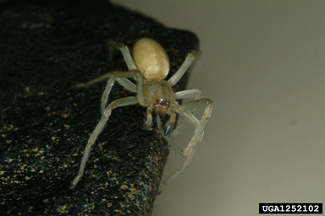The Sac Spider is No Angel!
By Chris Williams on August 28, 2015.

In general we say that spiders rarely bite people. When they do, it’s a defensive response when someone has stepped, or leaned, or most often rolled over on a spider while in bed. Sac spiders are one group of indoor spiders that is implicated in these defensive bites more often than other spiders. The reason is not that these spiders are bullies or that they are out to get you. They are just very restless nighttime hunters that bite defensively as a reaction to the lightest touch. The bite is described as painful, and leaves redness and localized swelling.
Sac spiders are common outdoors under materials lying on the ground such as boards, stones, and firewood. They can also be found in the upper corners of windows, behind shutters, under eaves, and in sheds, garages, and other outbuildings. Sac spiders also move into buildings, especially in the fall. They may stay hidden away in crawlspaces or voids where they feed on insects. Or, they may move into living spaces.
There are two sac spiders that can be found in homes: the yellow sac spider (Cheiracanthium mildei) and the yellow house spider (Cheiracanthium inclusum). They are about ¼ inch long and pale yellow to pale green in color, and are not hairy. Their shape is similar to the more well known brown recluse spider, but they are lighter in color and don’t have the brown recluse’s violin-shaped marking on their backs. These spiders move quickly and are known for climbing to ceilings and quickly dropping on a silken thread when disturbed. They also use silk lines to “balloon” to new locations.
Sac Spiders Rest in Silk “Sacs,” Not in Webs
Sac spiders get their name from the protective sac that they spin to hide in during the day (rather than in a web). The sac is a short, flat tube of silk that can be found in protected cracks or in upper corners where the wall meets the ceiling. The spiders rest in the sac during the day and also lay their eggs in the sac. Since each spider can construct multiple sacs, the number of sacs is not a reliable indicator of the number of spiders present. Large numbers of sacs can clog the inside of equipment, car parts, and outdoor appliances such as gas grills.
Vacuuming is a Good Control Method
A vacuum with a crevice tool is a good way to remove both the spiders and their sacs. Don’t leave the sacs behind because they may contain a spider or an egg mass. If you have spiders and sacs in high corners near the ceiling, give Colonial Pest a call. Our technicians have specialty vacuums and brushes with extender tips that are designed just to reach high-up spiders and spider webs. While they’re at your house, our technicians will also check for insect problems. Since spiders feed on insects, a large number of spiders may mean that you have an unseen insect infestation providing food. Give us a call!
Photo Credit: Joseph Berger, Bugwood.org